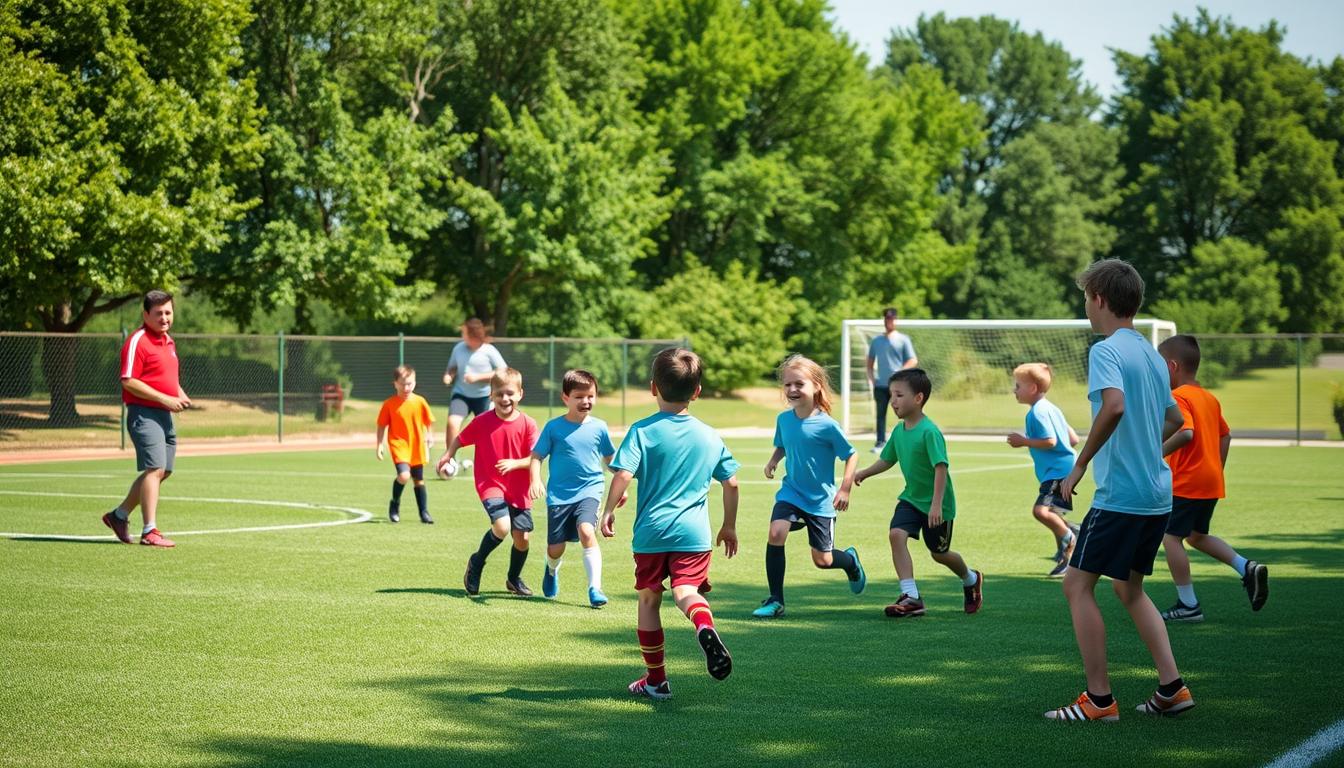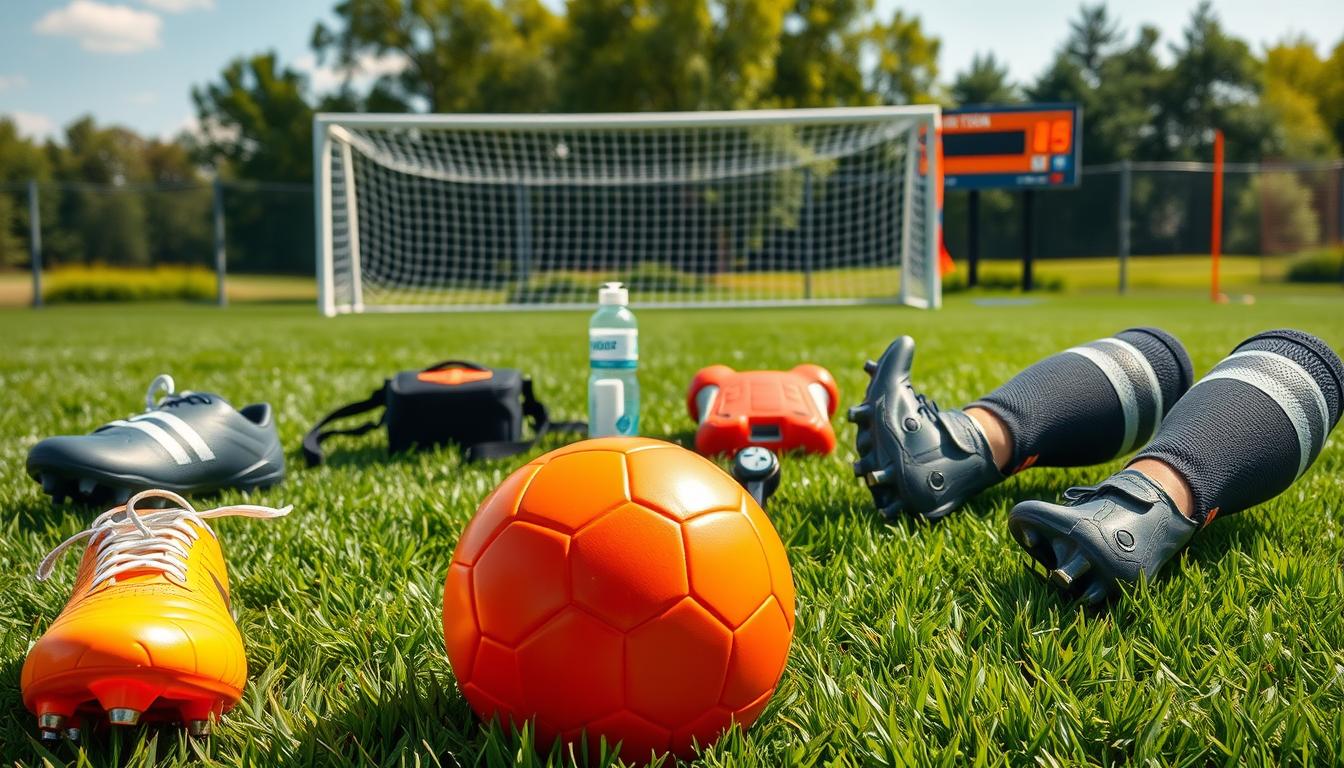Ensuring Soccer Field Safety for Kids Effectively

Imagine your child sprinting across a vibrant green pitch, laughing as they chase the ball. Soccer isn’t just the world’s most popular sport—it’s a way for young players to build confidence and teamwork. But even fun games need rules. Rough surfaces, loose equipment, or uneven terrain can turn excitement into avoidable injuries.
Experts like Dr. Mary L. Gavin emphasize that proactive steps matter. Simple checks—like inspecting goalposts or ensuring proper footwear—create a secure space for children to thrive. Research from Nemours Alfred I. duPont Hospital for Children backs this up, linking consistent safety habits to fewer sprains and fractures.
You don’t need to overhaul everything. Focus on small, consistent actions. Teach players to warm up, stay hydrated, and report hazards. Prioritizing these steps helps everyone enjoy the game while keeping risks low.
Key Takeaways
- Soccer’s global appeal makes safety practices vital for young athletes.
- Regular field inspections prevent common injuries like sprains.
- Proper gear and hydration are non-negotiable for safe play.
- Expert guidelines highlight the importance of adult supervision.
- Simple routines create long-term habits that protect children.
Overview of Soccer Field Safety for Kids
Young athletes thrive when their environment supports growth—not hazards. Roughly 35% of youth sports injuries stem from uneven surfaces or equipment issues. These setbacks keep players sidelined and disrupt their progress.
Guarding Against Common Injuries
Collisions and falls lead to most problems. Ankle sprains top the list, followed by muscle strains and head impacts. Overuse from repetitive motions also strains growing bodies.
- Twisted joints from sudden direction changes
- Head injuries during tackles or falls
- Fatigue-related strains after prolonged activity
Spotting Hidden Dangers
Playing surfaces need regular checks. Potholes, scattered objects, or slippery patches increase injury risk. Wet grass or loose turf can cause slips during quick moves.
- Exposed sprinklers or uneven ground
- Broken equipment like unstable goalposts
- Weather-related changes affecting traction
Quick daily inspections make a difference. Fixing small issues early keeps the focus on skill-building—not avoidable recovery time.
Essential Equipment and Prevention Steps
The right gear and a well-checked pitch keep young athletes focused on scoring goals, not injuries. Let’s break down what matters most.

Choosing Proper Gear
Fit is everything. Cleats should support ankles without pinching, while shin guards must cover from just below the knee to above the ankle. Soccer Pups recommends mouthguards even for casual matches—they reduce dental injuries by 60%.
- Cleats with rubber studs for grassy surfaces
- Lightweight shin guards with secure straps
- Moldable mouthguards for comfort
Nemours studies show ill-fitting equipment doubles scrape risks during sprints. Test gear monthly as kids grow.
Field Inspection and Preparation
Coaches and parents should walk the area 15 minutes before practice. Look for:
- Broken glass or sharp objects
- Uneven patches or holes deeper than 1 inch
- Loose goalposts or unstable corner flags
Fix small issues immediately. Mark larger hazards with cones until repairs happen. Pair these checks with developing new techniques to build confidence and coordination.
Regular maintenance—like filling divots—keeps play areas game-ready. Store gear in dry spaces to prevent mold or rust between uses.
Soccer Field Safety for Kids: Injury Prevention and Best Practices
Great practices start long before the whistle blows. Preparing muscles and mastering movement patterns help players stay strong throughout the game. Let’s explore how simple routines make a big difference.
Warming Up and Stretching
Dynamic warm-ups boost blood flow and flexibility. Start with light jogging followed by high knees or side shuffles. Leg swings and arm circles prepare joints for quick turns.
Focus on these moves for youth players:
- Hip openers: 10 reps per side
- Calf raises: 15 slow repetitions
- Torso twists: 30 seconds
Studies show active stretching cuts muscle strains by 40% compared to static holds. Keep sessions under 10 minutes to maintain energy.
Using Correct Game Techniques
Proper form prevents soccer injuries. Teach players to head the ball with their forehead, not the top of the head. Knees should bend slightly during impact to absorb force.
Coaches can reduce concussions risk by:
- Limiting heading drills for players under 12
- Using foam balls during practice
- Encouraging verbal calls to avoid collisions
Structured passing drills improve spatial awareness—a key skill for safer games. Remember, hydrated athletes make better decisions. Keep water breaks every 20 minutes.
Field Maintenance and Player Safety Strategies
A well-kept pitch is the foundation of every great game. Consistent care ensures predictable ball movement and reduces unexpected hazards. Let’s explore how smart upkeep protects players while keeping the action flowing smoothly.
Routine Field Inspections
Walk the area before each practice or match. Look for uneven patches, loose debris, or worn-down markings. Fixing divots immediately prevents tripping during quick turns.
Pay extra attention to high-traffic zones like goalmouths. These spots need weekly over-seeding to maintain turf density. Compacted soil here affects ball control and increases contact injuries.
Managing High-Wear Areas
- Fill holes deeper than 1 inch with sand-soil mix
- Repair torn turf within 24 hours to prevent spreading
- Repaint boundary lines monthly for clear visibility
Properly maintained surfaces help players anticipate the ball’s bounce. This reduces awkward landings that lead to ankle sprains.
Communicating Safety Standards
Share inspection checklists with coaches and staff. Highlight these priorities:
- Replace worn cleats with broken studs
- Discourage chewing gum to prevent mouth injuries
- Report loose corner flags immediately
Quickly address small issues like pebbles or wet leaves. These minor hazards cause 18% of non-contact sprains during playing sessions. Regular team briefings keep everyone alert and proactive.
Final Thoughts on Keeping the Game Safe and Fun
Keeping the game enjoyable starts with smart habits both on and off the pitch. Simple steps—like checking gear and surfaces—go a long way in preventing strains. Regular routines ensure players stay focused on fun, not injuries.
Make inspections part of your pre-game ritual. Spotting hazards early saves time and keeps everyone safe. Proper hydration and warm-ups also cut down on muscle strains during play.
Taking action at the right time matters. Fix small issues before they become big problems. Share these practices with coaches and parents to build a culture of safety.
By prioritizing these steps, you create an environment where skills grow and laughter thrives. After all, the best games happen when safety and fun work as a team!
